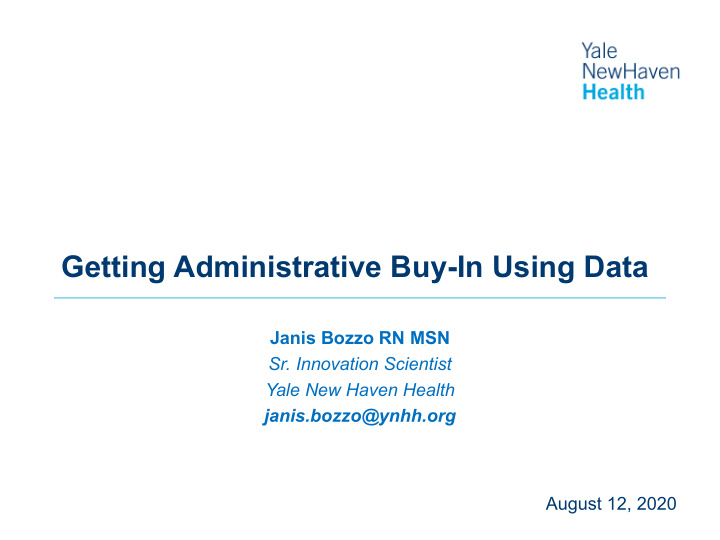



Getting Administrative Buy-In Using Data Janis Bozzo RN MSN Sr. Innovation Scientist Yale New Haven Health janis.bozzo@ynhh.org August 12, 2020
Goals of session • How to collect and interpret data on o your adult SCD patients’ health services utilization. o the impact of your patients’ utilization patterns upon institutional finances. • Strategies to engage your institution in supporting your program.
YNHH’s Story • Yale University School of Medicine • 1,541-bed Academic Medical Center in urban New Haven, CT • Flagship for 5-hospital health system.
2010: Clinical Point of View Chaos on the Floors • Inconsistent MD attitudes/approaches towards pain management • IV morphine/Dilaudid by push, scheduled and PRN • Frequent, prolonged hospital stays and in the Clinic • Infrequent arrived clinic visits
Finance Point of View
Adult SCD Program Business Plan • Invest • Medical Director • Inpatient and Outpatient APRNs • Inpatient Social Worker to augment existing Outpatient Social Worker • Psychiatrist embedded in clinic; inpatient Behavioral Intervention Team (BIT) • Goal: reduce inpatient ALOS from 11.5 to 7.5 • Reduce Direct Costs • Increase Contribution Margin • Increase Operating Margin
Program Outcomes – Finance View: Inpatient ALOS Reduction
Clinically Relevant Data • Patients • Utilization • ED • Hospital • Clinic • Infusion Center
Population Definition for Data Capture • Principal Diagnosis of SCD vs. Principal *or* Secondary Diagnosis of SCD? • Age: Adult? Pedi? Adult: Age 18+? Age 21+? • • Sites of Service Selected Campus/ Department? • Inpatient: Selected Nursing Unit(s)? • Outpatient: ED, Observation, Clinic, Other • • Other Considerations Validate SCD diagnosis through additional criteria? * • * Michalik et al, Identification and Validation of a Sickle Cell Disease Cohort within Electronic Health Records, Academic Pediatrics, 2017;17:283-287
ICD-10 diagnosis codes for Sickle Cell Disease D57.00 - Hb-SS disease with crisis, unspecified D57.01 - Hb-SS disease with acute chest syndrome D57.02 - Hb-SS disease with splenic sequestration D57.1 - Sickle-cell disease without crisis D57.20 - Sickle-cell/Hb-C disease without crisis D57.211 - Sickle-cell/Hb-C disease with acute chest syndrome D57.212 - Sickle-cell/Hb-C disease with splenic sequestration D57.219 - Sickle-cell/Hb-C disease with crisis, unspecified D57.40 - Sickle-cell thalassemia without crisis D57.411 - Sickle-cell thalassemia with acute chest syndrome D57.412 - Sickle-cell thalassemia with splenic sequestration D57.419 - Sickle-cell thalassemia with crisis, unspecified D57.80 - Other sickle-cell disorders without crisis D57.811 - Other sickle-cell disorders with acute chest syndrome D57.812 - Other sickle-cell disorders with splenic sequestration D57.819 - Other sickle-cell disorders with crisis, unspecified Exclude: D57.3, Sickle Cell Trait
Program Outcomes: Clinical/ Operational View Visit volumes adjusted for number of unique individuals.
Financial outcomes of re-organization ?
Billing & Reimbursement Your program likely has two billing entities: • Hospital (facility fees). • Physicians and APPs - professional fees (“pro fees”), based upon RVUs generated by billing E&M CPT codes. • Telemedicine may generate professional fee only.
MD and APP Billing & Reimbursement • Difficult to support a medical director’s effort on pro fees. • Consider the feasibility of the Hospital (or practice plan or school of medicine) supporting the medical director’s effort.
Hospital Billing & Reimbursement Two types of payment arrangements: • Fee for service o Contract based. o Reimbursement based on negotiated payments. o Usually commercial insurance. o Revenue usually > Hospital Costs. • Case based reimbursement o Reimbursement based on fixed payments (APCs / DRGs). o MCaid/ MCare plus a growing number of commercial payors. o For MCaid/ MCare, revenue usually < Hospital Costs.
Hospital Financial Data: Charges, Costs and Revenue with examples from one patient visit Cost: Charge: Sticker price. Cost to the Provider Source: “Direct” vs. “Indirect” Chargemaster Source: Cost Accounting $30,992 $15,098 Net Revenue: Summary Payments: Expected payment. Actual payment . Source: Contracts; MCare & MCaid Payment rates. $0 $17,488
Important Financial Calculations • Contribution Margin (“CM”): Net Revenue minus Direct Cost • Operating Margin (“OM”): Net Revenue minus Total Cost
YNHH - FY 2010 Statement of Revenue and Expenses Inpatient Discharges
Inpatient-Outpatient Direct Cost Changes
Financial Success – Cost Reduction Cumulative Savings over 6 years, FY 2013-2018*: • Inpatient direct cost decrease: $14.8M • Outpatient direct cost increase: $1.8M • Total Inpatient and Outpatient: $13.0M in cumulative savings *Sum of costs for each year, 2013 to 2018, minus cost of baseline year, 2012.
Contribution Margin for Inpatient Discharges Before After
Additional Benefit: Freeing up Beds for Other Patients Inpatient Average Daily Census
Additional Benefit: Freeing up Beds for Other Patients Inpatient Payor Mix Adults with SCD Adult General Medicine
Important Consideration: 340B • Drug pricing program for outpatient medications, including infusions such as high-cost chemotherapy as well as P.O. medications. • Administered by U.S. Health & Human Services. • Intended to reduce federal costs and make high-cost medications more affordable for economically &/or medically vulnerable patients. • Eligibility determined at the institution level: Medicare/Medicaid Disproportionate Share Hospitals, children’s hospitals, other safety net providers .
340B Opportunity Example Jadenu (Deferasirox) 360mg NDC: 00078065615 / 30 Tablets Average Wholesale Price $5,630 Manufacturer-recommended price (AWP) for hospital to sell Jadenu. Typical AWP Contract Pricing -17.5% Discount that payors negotiate to pay hospital for medication. Revenue Received per $4,640 Amount that hospital receives for Package medication from payors. Jadenu 340B Price $2,310 Cost to hospital for medication from manufacturer. Contribution Margin (CM) per $2,330 Margin for hospital for medication Package ($4,640-$2,310) CM per patient, per year $56,697 Assumes 720mg per patient/day.
Summary • Data – work with institutional partners (Finance, Data Analytics) to develop data analysis and display. • Focus on Value – better care, reduced cost.
Acknowledgements Dr. John D. Roberts and the Adult Sickle Cell Team
Recommend
More recommend